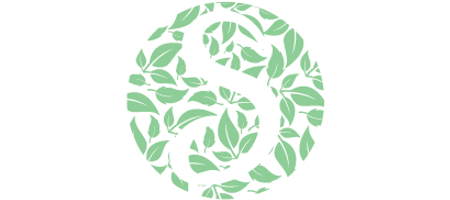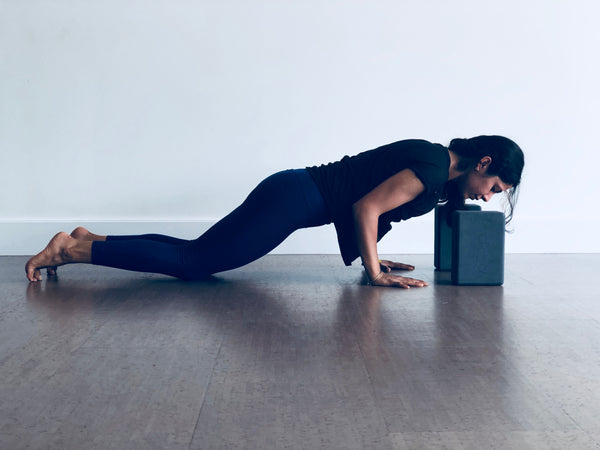Chaturanga Dandasana: Four-Limb Staff Pose
BENEFITS
A foundational pose for:
- Arm Balance
- Core Strength
- Shoulder Stability
- Leg Muscle Activation
WHY I LOVE IT
This pose is hard to master but once you get the hang of it, you will fall in love with it! I love it because it draws on strength from all body parts and forces you to activate them all.
KHUSH'S TIPS TO MASTER IT
Full Pose- From the plank position (wrists under shoulders and on the balls of your feet), move your body forward so you land on your tippy toes and not the balls of your feet.
- Make sure your shoulders are over your wrists, not above it.
- Lower your arms only halfway so that your upper arm is parallel to the ground, and your elbows are squeezing against the side of your body.
- Make sure your core, quadriceps, and arms are fully engaged and remember to keep your gaze forward!
- We can come out of Chaturanga Dandasana in a number of ways, but the most ideal (though not easiest) is to return to the plank position.
- Push the floor away, extend the arms and use your core muscles to return to the plank.
- Come to a standing position and extend your arms in front of you, with palms facing forward as if you are pushing someone away.
- Now firmly squeeze your upper arms, especially your elbows, against the side of your body. When you do this, your forearms and palms will remain in the same position in front of you.
- This is the action that you need in your Chaturanga: keeping your elbows in line with the side of your body is the key. Your elbows should not go behind the body as that’s how we injure our shoulders!
- Plank: From plank position (where you are on the balls of your feet and your wrists are below shoulders), lower your knees, and move your body forward so that your shoulders are over your wrists as you rock to your tippy toes (see picture above). Make sure to lower only halfway so that your elbows hug against your ribs.
- Blocks: Another way to avoid shoulder injury and make sure that your elbows don’t move behind your body, is to use blocks underneath your shoulders (at maximum height as in picture below). By doing this, we create a boundary for ourselves. When we lower down halfway, we make sure that our shoulders don’t touch the block and can recognize how far we need to go down at this point.
- With blocks, we can do a full chaturanga or lower our knees and do half push up.
- Elbows should never move behind your body. By doing this we put our shoulders at risk. Tip: If you can’t keep your elbows in line with the side of your body, I will highly suggest the Supported/Modified version of Chaturanga or practicing the plank to build that arm strength first ;)
- Torso should never lower below the elbows (this is the result of weak core muscles but we can build this strength overtime). The key is to modify our poses until we can master it so that we are not putting our body at risk for injury or strain.
- Shoulders should not go into extension. Stability around shoulders is really important.
Most importantly, enjoy learning the pose and take your time! It will get easier with practice :)
In Gratitude,
Khush
P.S. Want More Yoga? Try Bakasana next!
 Khush-means "happy." I hope I can justify having this beautiful and happy name and bring a smile to your face every time we connect (virtual or in person). Who am I? I am one happy person who loves to learn and explore nature, go on long hikes with my dear husband, and just live life really simple. Good food is my true love and my husband is my inspiration. And Yoga is something that I go back to every day for my "moksha"- liberation and introspection. My Yoga journey started almost 8 years ago in India and it has only grown since then. I recently finished my 200hr RYT from Citizen Yoga, Metro Detroit and I am ready to share my practice with the world. My teaching style is focused on fun, alignment, building core, and being mindful of my students' (and that is my family right now :) needs and limitations. I think it's important to acknowledge that everyone is unique in their own special way and none of us have to have the same physical goals. My hope is that my students will learn to self-reflect and bring mindfulness to their practice. Oh, and asking questions and having fun should be a priority! That's what life is about 😊
Khush-means "happy." I hope I can justify having this beautiful and happy name and bring a smile to your face every time we connect (virtual or in person). Who am I? I am one happy person who loves to learn and explore nature, go on long hikes with my dear husband, and just live life really simple. Good food is my true love and my husband is my inspiration. And Yoga is something that I go back to every day for my "moksha"- liberation and introspection. My Yoga journey started almost 8 years ago in India and it has only grown since then. I recently finished my 200hr RYT from Citizen Yoga, Metro Detroit and I am ready to share my practice with the world. My teaching style is focused on fun, alignment, building core, and being mindful of my students' (and that is my family right now :) needs and limitations. I think it's important to acknowledge that everyone is unique in their own special way and none of us have to have the same physical goals. My hope is that my students will learn to self-reflect and bring mindfulness to their practice. Oh, and asking questions and having fun should be a priority! That's what life is about 😊



